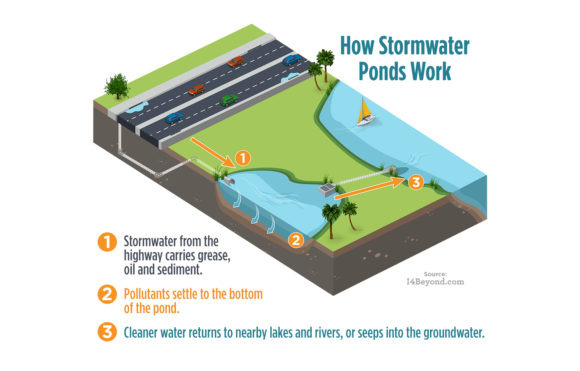Floridians are no strangers to precipitation. Florida’s rainy season typically runs from late May to early October, which on average sees between 5 to 10 inches of rainfall per month from frequent afternoon thunderstorms in the state’s humid subtropical climate.
Rain is often responsible for roadway runoff that contains oil, grease, and sediment and can lead to both flooding and pollution of nearby water features. Engineers tasked with addressing roadway runoff frequently employ
Stormwater ponds are designed to collect the overflow of roadway runoff and allow pollutants to settle at the bottom, leaving only the clean water at the top of the pond to return into nearby lakes, rivers, or groundwater. The use of stormwater ponds is proven to be effective at preventing pollutants from getting into natural bodies of water and causing negative impacts on local ecosystems.
The Sand Lake Road (State Road 482) and Interstate 4 (I-4) interchange project is constructing new stormwater ponds near a new loop ramp that will move westbound traffic from Sand Lake Road to Turkey Lake Road. Their locations were selected after engineers conducted geo-technical investigations to understand the ground elevation, water table, and soil makeup under the roadway.
The next time you drive by a humble roadway stormwater pond, take a moment to appreciate the important work they perform in keeping our waterways clean!
To learn more about the Sand Lake Road and I-4 interchange project, visit i4beyond.com/SandLake.



 ATTENTION DRIVERS: Overnight Westbound I-4 Exit Ramp Closure at Sand Lake Road (Exit 74A) January 7
ATTENTION DRIVERS: Overnight Westbound I-4 Exit Ramp Closure at Sand Lake Road (Exit 74A) January 7 S.R. 528 Ramp-Widening Improvements Near Completion
S.R. 528 Ramp-Widening Improvements Near Completion I-4 Beyond the Ultimate: 2025 Wrapped
I-4 Beyond the Ultimate: 2025 Wrapped 60 Never Looked so Good: Happy Birthday, I-4!
60 Never Looked so Good: Happy Birthday, I-4!